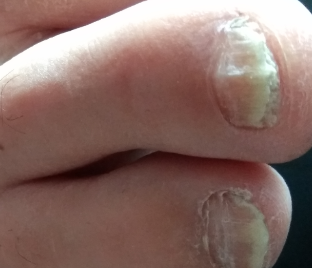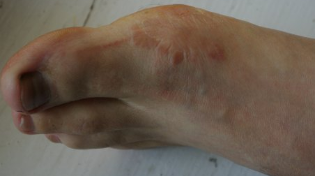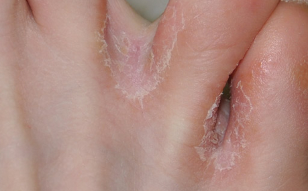If you recognize the fungus on the feet in the initial stage and the time of starting the treatment, there is a high probability of a quick recovery with a minimal use of antifungal drugs, most of them represent a health hazard (especially to the liver) during long periods of reception. Unfortunately, not always and not everyone can react to time in the early bells of the emergence of fungal defeat, as well as the symptomatology in the initial phase is very similar to the harmless skin manifestations. A familiar feeling, when they found a yellow speck on the plate of the nail into the toe and the first thoughts that come to mind – anything to cut that growing a healthy, clean nail of a finger or been hit at some time, will soon pass. Or appears a small scaling in the interdigital folds, which in 90% of the blame to the dryness of the skin and begin to manage the moisturizers. And then, all those "harmless" demonstrations more often and hides of all known and hated of fungi on the feet.
Trigger factors and sources of infection

Pregnancy can cause the development of fungal diseases, as well as the women in this period, we can observe a drastic decrease of the immunity and the violation hormonal.
Fungi on the feet, as many of the disease, can not develop by itself its appearance and progression of the necessary existence of an enabling environment. There are a number of factors and diseases that cause the onset of this disease:
- the drastic reduction of the immunity;
- the absence or violation of personal hygiene;
- increased sweating;
- diabetes mellitus;
- obesity;
- flat feet;
- the disease of the vessels of the lower extremities;
- permanent abrasion and the wound;
- the operational engagements, etc
We have made a list of the most popular of the causes of the occurrence of fungi on the feet, but even the poor diet or the prolonged use of antibiotics can also be the cause of the development of the mycosis.
The infection occurs most often after using the shoes of the sick person, or a visit to the public baths. In recent years, also noting the rapid growth of the spread of fungal infection through the cuticle of the apparatus. The sources of infection more we can highlight:
- articles of personal hygiene of the sick person (sponge, pumice stone);
- things of the infected person (socks, stockings, shoes, slippers, pants);
- the floor (especially wood) in bathrooms, showers, gyms.
The causal agents of foot fungus is very resistant to the environment and differ in that can a long time be latent in the wood, towels, socks. The period of exacerbation of the spring and the fall.
How to recognize the fungus of the feet in the initial stage?

Here experienced dermatologists recommend to pay attention not only external, but also internal signals. To call the attention, that they're all going to the bath house, swimming pools, sunbathe on the beach, but the fungus only affects the smoker people? The thing is that for its development requires an enabling environment – decrease of the resistance of the body. This condition can occur in the presence of co-morbidities or recently transferred to the treatment activities, during which they used antibiotics or hormonal drugs.
Now let's talk about the demonstration of the fungus in the skin of the feet. The main symptoms are:
- the cracks in the interdigital folds;
- peeling between the toes;
- hardening of the skin on the heels;
- comes from the skin of the feet, the fingers;
- the deformation of the nail plate (thickening or thinning);
- discoloration of the nail (yellow, brown, black);
- the redness and swelling of the feet;
- the appearance of red spots on the hips and the inner part of the legs;
- the scales of the entire surface of the foot;
- pruritus of variable intensity (depends on the location and the pathogen);
- smell foul (it is most often seen in people who suffer from high sweating).
When deep mycosis can be observed the appearance of vesicles, crusting, and fissuring, accompanied by itching and pain of the sensations. In some cases, the foci of the defeat are in place, that due to the severe pain does not have the opportunity to become a leg. This can lead to temporary disability and mobility problems.
Types and classification
As you already know, mycoses can be caused by many different pathogens, from this, can vary in function of the location of the foci of injury. Most often fungal in feet can be caused by:
- dermatomycosis;
- candido mycosis;
- mycosis deep.
All of the mycosis stop that today are considered to be self-sufficient, diseases caused by different pathogens, and localized in various areas of the feet, but they are all united by a name – the fungus on the feet. The most common of them:
- Rubrofitiya stop. Around 60% of all mycoses of the feet. It is characterized by a high transmission and incidence in some sectors of the population. The initial stage of the rubromikoza stop characterized by the defeat of between the fingers of the folds on the legs. In the future, in the process involving the outsole and the inner part of the soles of the feet. The defeat of nail plastic when rubrofitii is observed in each third person. Very often it is combined with the fungi in the hands, especially when widespread rubromikoze.
- Epidermo mycoses. To them carry two individual disease – Epidermofitiya stop and Epidermofitiya inguinal-femoral folds. In both cases, the foci of the defeat is localized in the legs. Epidermofitii stop are characteristic of the defeat of the folds between the toes, the sole and the back of the foot. Less often, the process extends on nails (normally, V and I the toes of the feet). The foci of the defeat covered scales and lesions become scabs. There is pruritus of variable intensity. In acute cases, may experience general malaise, and headache. Hernia, inguinal Epidermofitiya manifests itself in the form of large, flaky patches on the groin, on the inner side of the legs, the hips and the perianal region. The foci of the defeat they can reach the size of a large plate, accompanied by a little itching, flaking and swelling.
- The onychomycosis. Each year, the prevalence of fungal infections of the nails constantly. Only now (according to statistics in mid-2016) is 10-18% of russians are diagnosed onychomycosis nails of different degrees of severity. Of great importance in their development play social and environmental factors. Also in the risk zone are people who have problems with the cardiovascular system, the immune and the endocrine system. Men suffer from 1.3 times more than women. Children onychomycosis in very rare occasions, the peak of the prevalence in people aged 50 to 70 years.
- Candidiasis. Rarely, but led to the defeat of the feet due to fungus Candida. In isolated cases, Candida balanoposthitis can spread to the genitals in the perianal area and groin-folds. A little more often the yeast fungus found in the nails. In the initial phase marks the pain of a roller, if you are pressed in which may occur the pus. With time, its color takes on a brown coloration-with a brown tone.
There are still rubrofitiya soft skin, but the foci of the defeat when she rarely found on the feet. And here rubromikozu in the groin is characteristic of the defeat of the inner part of the legs of red spots.
Treatment and prevention of
The diagnosis of foot fungus include the inspection of its clinical picture, the decision of scraping with foci of defeat, the realization of a microscopic examination (are filaments of mycelium) and bacterial seeding to the definition of culture of fungi. Before visiting the doctor you can't control the foci of the defeat by any means! The differential diagnosis is carried out with the eczema, rashes and contact dermatitis.
The treatment Epidermofitii and rubrofitii in the groin is performed with the help of external medications (more often Clotrimazole). Prognosis positive, the duration of treatment is rarely more than a month. As prevention it is recommended that the treatment of the foci of the defeat spirituous solutions, if there is itching may be assigned to the antihistamines.

More complicated is the case of mycosis stop, and onychomycosis, since even the initial phase are very difficult to treat and prone to relapse. The most effective is considered to be the combination of external and system of drugs, the strict compliance of the dosage, and personal hygiene of the rules of disinfection. Well it has been a combination of diflucan in capsules, and the treatment in the form of ointment (treatment of the foci of the defeat 2p/day for a month). A lot of attention to the fungus of the feet is given to the handling of the shoes and the socks, that may be the cause of a relapse. Socks of preference to boil or to wash at a temperature of 90 degrees, templates, and shoes in the interior must be handled by the solution of the chlorhexidine.
And most important, remember that today the fungus on the feet, detected in the initial stage, is treatable with modern drugs, and here you are running the onychomycosis and mycosis stop can be treated for months and even years.
















